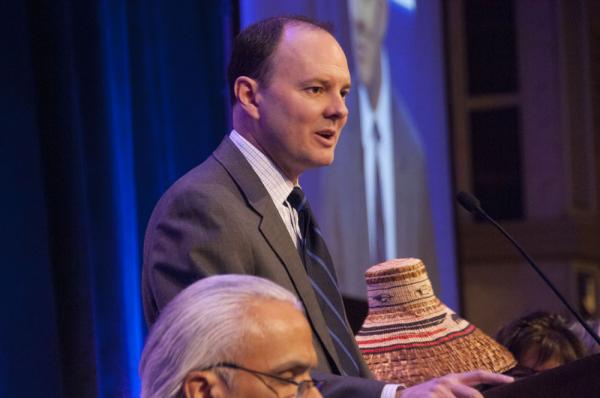Land Buy-Back Program: Participants Wait for Next and Possibly Last Phase

Tribes and individuals have until March 11, 2016 to let the U.S. Department of the Interior know they may want to participate (though not be committed to anything) in the next phase of the Land Buy-Back Program for Tribal Nations.
Since 2013 the program has paid Native American landowners nearly $715 million for their interests in land parcels and returned 1.5 million acres of land to tribal trust ownership, says Interior Assistant Secretary – Indian Affairs Kevin K. Washburn, who says the program has been “incredibly successful.”
So far Interior has selected 42 reservations for land-consolidation activities scheduled through mid-2017. The department is now asking landowners willing to sell their interest in land parcels and tribes interested in working with DOI on land consolidation to be in touch as planning begins for the next – and probably last – round of purchases, scheduled for mid-2017 through 2022, when the program ends.
DOI has identified 150 reservations eligible for the program. Washburn notes, “There are about 245,000 owners of nearly three million fractional interests across Indian country who are eligible to participate in the buyback program.” The department is beginning outreach efforts, including public service announcements, events, paid advertising, working with federal agencies and other partners and sending postcards to individuals, for the next phases of the program. Individuals who believe they may be eligible to participate are encouraged to call the Trust Beneficiary Call Center at (888) 678-6836 or to visit or call the Office of Special Trustees for American Indians to register their interest and confirm contact information. Registering does not commit an individual to participating in the program.
The program’s 2015 Status Report includes an analysis of the economic impacts of the program. “Cumulative program payments to landowners as of September 2015 have contributed an estimated $752 million to gross domestic products, copy.4 billion in the output of goods and services and support about 9,000 jobs nationwide as a result of the inputs of funds into the area and associated spending,” says Deputy Secretary of the Interior Michael L. Connor.
Fractionation of land resulted when the U.S. government divided up tribal land into allotments and assigned those allotments to individual tribal members. When the tribal member passed on, his allotment was divided among his heirs and after several generations the land has come to belong to so many different individuals – sometimes thousands for a single tract of land – that it has become virtually unusable, and the proceeds of leases for mineral rights and other uses of the lands can amount to just pennies for each landowner—when they get anything at all.
The land consolidation program came about as the result of a class action lawsuit filed in 1996 by Elouise Cobell, Blackfeet, and others alleging that the federal government had mismanaged the accounts (Individual Indian Money or IIM accounts) through which individual landowners were supposed to be paid royalties for leases and mineral extraction. The lawsuit demanded an accounting of the billions of dollars that individual landowners should have received.
In 2010, Congress approved a negotiated settlement between the federal government and the plaintiffs. That settlement (no accounting ever took place) provided copy.5 billion for the 300,000 IIM account holders and established a copy.9 billion Consolidation Fund for use by the Secretary of the Interior to buy up fractionated land parcels from owners who are willing to sell. The fractionated interests are thus consolidated by the federal government and returned to tribes as trust land. The tribes may then use “consolidated land for purposes consistent with the values and needs of their members whether for housing, community centers or businesses or recreational cultural or other purposes,” according to Connor.
Washburn details some of the benefits already realized by tribes as a result of the program. “The Oglala Sioux Tribe Pine Ridge is embarking on a major housing program and they’re using the land that we recently acquired for them through the program to do the housing project. The Gila River Indian Community near Phoenix in Arizona is increasing its energy and economic sovereignty by pursuing an electrical transmission utility corridor on the community’s reservation. The Squaxin Island Tribe has been able to [utilize] national resources by increasing its sovereignty over fishing rights. The Squaxin is now better able to protect its world class oyster beds.”
In addition, the land consolidations program will contribute up to $60 million to the Cobell Education Scholarship Fund for AIAN students attending post-secondary educational institutions. As of September 30, $30 million has gone into the scholarship fund and the American Indian Graduate Center is expected to begin distributing approximately $2.5 million in the first round of Cobell Scholarships in the next several months. “Scholarship recipients represent more than 80 tribal nations who will be attending more than 175 different academic institutions,” says Connor.
DOI has scheduled a listening session for March 3 in Albuquerque to hear comments on the program from tribes, landowners and others. Comments may also be submitted by email at buybackprogram@ios.doi.gov or by mail at U.S. Department of the Interior Land Buy-Back Program for Tribal Nations, 1849 C Street NW, MS-5552-MIB, Washington, DC 20240.
Read more at http://indiancountrytodaymedianetwork.com/2015/11/12/land-buy-back-program-participants-wait-next-and-possibly-last-phase-162408